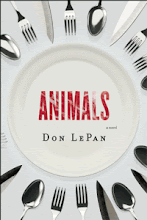In The New Yorker piece, Ivan, a twenty-two-year-old chess player who has won a series of ten demonstration matches for a chess club in an Irish village, is ferried about afterwards by thirty-six-year-old Margaret (the local arts group organizer), first to a pub and then to a holiday cottage that the chess club has booked for Ivan’s accommodation. Somewhat awkwardly, he invites her in, somewhat awkwardly they engage in more conversation, and then somewhat awkwardly—but much less awkwardly as things progress—they make love. The description of the lovemaking is detailed but not in the least salacious; it focuses for the most part on the psychological (switching back and forth between points of view) without ever shying away from the physicality of it. And the sex depicted is good sex, in every sense of the word good; the characters care about giving each other pleasure—and they care about each other, full stop. It’s explicit sex, but it truly is also lovemaking.
Writing about sex in ways that keep the reader’s imagination consistently engaged in the psyches of the characters is far from easy. (Were that not the case, there would never have been a “Bad Sex in Fiction” award; for anyone unfamiliar with the now-defunct award, the Independent’s December 3 2019 compilation of “The 23 best/worst winners of the Bad Sex in Fiction awards” is highly recommended.) To write well about sex you have to have a deep understanding of the characters’ psyches; you have to eschew coyness and avoid euphemism; you have to convincingly convey the degree to which the characters are aroused without pivoting into prose focused on arousing the reader; you have to guard against the unintentionally comic just as firmly as you have to guard against the pornographic. Writing about sex, in short, is an extraordinarily difficult art—and no one writing in English today is better at it than is Sally Rooney. Quite possibly, no one has ever been better at it.
The account of Ivan and Margaret first making love extends over 4 ½ pages in Intermezzo. Here is how it appears in the New Yorker piece:
Pressed against her, his body is thin and tensed and shivering. And what if life is just a collection of essentially unrelated experiences? Why does one thing have to follow meaningfully from another?There’s a line space, but there are no ellipses; nothing indicates that a 4 ½-page section of text has been omitted between “meaningfully from another” and “in the morning.”
In the morning, Margaret wakes alone in the holiday cottage to the sound of her alarm: Saturday, 8:30 a.m.
So far as I can tell, neither the magazine nor the author has said anything publicly as to why the sex scene was left out of the New Yorker piece. If you ask Google’s AI engine why the sex scene might have been omitted, it cleverly offers this as an explanation:
The New Yorker, known for its literary and intellectual focus, might have made a conscious decision to prioritize the novel's exploration of relationships and emotional dynamics over a detailed depiction of a sex scene.But that won’t do. In dealing with “emotional dynamics” in Intermezzo (and indeed in all her novels), Rooney always unflinchingly acknowledges the ways in which sex—sexual desire, sexual interaction, sexual frustration—plays a fundamental role in those emotional dynamics. To excerpt a Rooney novel in such a way as to separate lovemaking and emotional dynamics is to go entirely against the grain.
Could it be prudishness? Squeamishness? A sense that explicit sex constitutes inappropriate content in a magazine for readers of all ages? No, is the short answer to those possibilities. The New Yorker has never been a magazine for readers of all ages, and under the auspices of Deborah Treisman (the New Yorker’s fiction editor since 2003) the magazine has published a number of stories that portray sex explicitly. Curtis Sittenfeld’s “The Prairie Wife,” for example, which appeared in the February 5, 2017 issue; includes passages such as this one:
During the next five nights—the counsellors stayed an extra forty-eight hours to clean the grounds after the kids went home—Kirsten and Lucy were naked together a lot. The second night was both the first time someone went down on Kirsten and the first time she had an orgasm; the orgasm part happened more than once. She was less drunk than the night before, and at one point, while Lucy was lapping away at her, she thought that, all things considered, it was good that it was happening with a girl first, because then when a guy went down on her, when it mattered, Kirsten would know what she was doing.Miranda July’s “The Metal Bowl”—direct about sex, if not quite so explicit as the Sittenfeld story—appeared in the August 28, 2017 issue of the magazine. And, in its December 4 issue that same year, The New Yorker published “Cat Person,” Kristen Roupenian’s now-famous short story on the theme of bad sex. It is nothing if not explicit:
After Kirsten had basically spasmed in ecstasy into Lucy’s face, she said, “Could you tell I’d never done that?”
The more she imagined his arousal, the more turned-on she got, and soon they were rocking against each other, getting into a rhythm, and she reached into his underwear and took his penis in her hand and felt the pearled droplet of moisture on its tip. He made that sound again, that high-pitched feminine whine, and she wished there were a way she could ask him not to do that, but she couldn’t think of any. Then his hand was inside her underwear, and when he felt that she was wet he visibly relaxed. He fingered her a little, very softly, and she bit her lip and put on a show for him, but then he poked her too hard and she flinched, and he jerked his hand away. “Sorry!” he said. And then he asked, urgently, “Wait. Have you ever done this before?”According to Roupenian, The New Yorker was not the first magazine she had sent “Cat Person” to: “the story … had already been rejected, politely, by every other publication I’d sent it to” (“What It Felt Like When ‘Cat Person’ Went Viral,” The New Yorker, January 10, 2019). The story did indeed go viral, with many readers judging it to be a well written as well as a persuasive piece of fiction, and many women attesting that they could relate to the plight of the central character (a young woman who feels she has to go through with a sexual encounter, even after she stops enjoying herself). But there was also a powerful backlash. A Twitter thread (@MenCatPerson) was entirely devoted to men venting, calling “Cat Person” “garbage” and “shit.”
In the years since “Cat Person” was published, my sense is that there has been a good deal less by way of explicit treatments of sex in New Yorker fiction than there was in the stories it published in 2017. Perhaps that’s just my imagination (or my faulty memory). Or perhaps there have just been fewer authors in the past few years writing well about sex and submitting their stories to The New Yorker. But one other possibility occurs to me—that the controversy over “Cat Person” might have had a long-lasting effect, leading The New Yorker (whether the fiction editor herself or, perhaps more probably, the magazine’s management) to shy away from fiction depicting sex with some explicitness—no matter how well written. It would be a sad irony if the 2017 backlash against a good story about bad sex resulted in a 2024 decision to leave out the sex in a good story about good sex.





